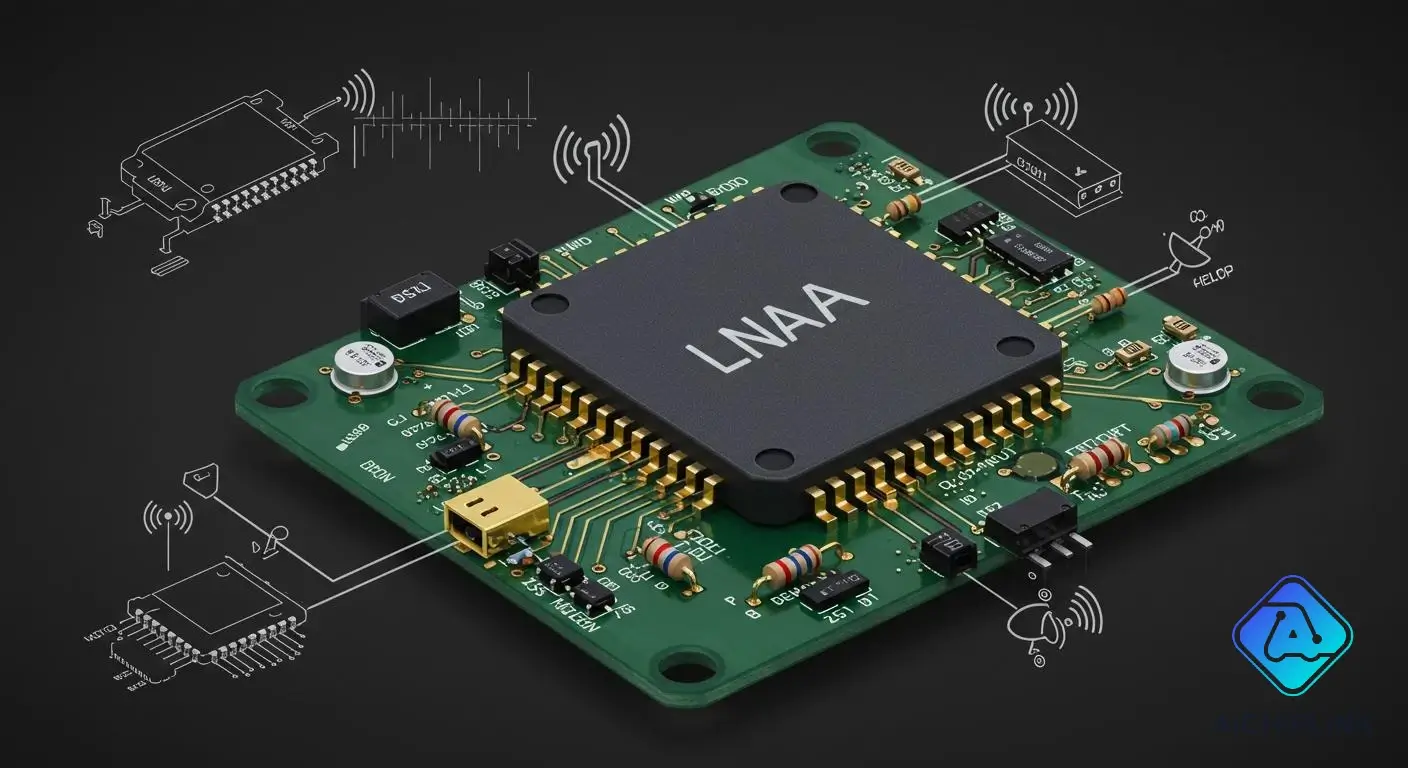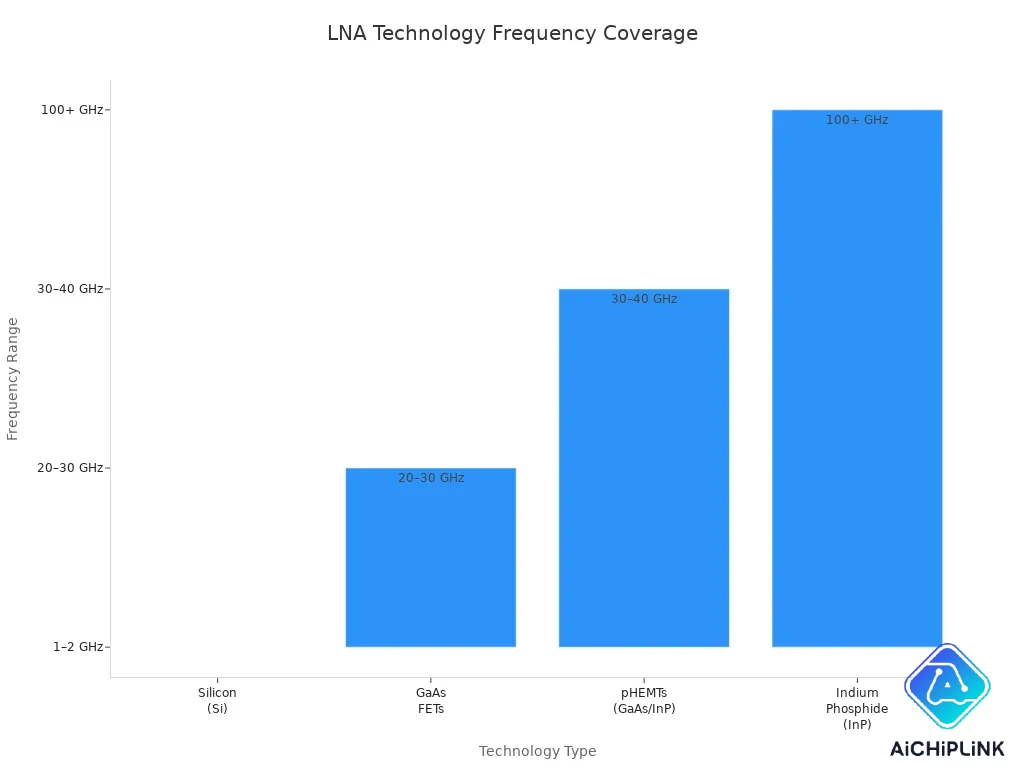
You use a Low Noise Amplifier to make weak signals stronger. It does this without adding a lot of noise. This device helps you keep the signal clear. That is important for wireless communication like Wi-Fi and radio. Many engineers say a Low Noise Amplifier helps you find small signals. It matches input impedance. It makes your receiver work better.
-
It fixes design problems in short-range wireless devices.
-
It helps you find the smallest signal you can detect.
Key Takeaways
-
A Low Noise Amplifier (LNA) makes weak signals stronger. It does not add much noise. This helps wireless communication stay clear.
-
Put the LNA near the antenna. This makes the signal better. It also stops signal loss from cables.
-
Pick an LNA with a low noise figure. This helps your system find weak signals. It makes your system more sensitive.
-
Impedance matching is very important. It helps send power well. It also stops signal loss in RF systems.
-
LNAs are used in many devices. You can find them in cell phones. They are in Wi-Fi networks. They help medical imaging equipment. LNAs make signals strong and clear.
Low Noise Amplifier Basics
Signal Amplification
A Low Noise Amplifier helps make weak signals stronger. It sits at the front of a receiver. It boosts faint radio signals from an antenna. The amplifier should not add much noise.
-
A Low Noise Amplifier does three main things:
-
It makes low-power signals bigger without hurting the signal-to-noise ratio.
-
It keeps extra noise low when making signals stronger.
-
It balances noise control with power gain and matches impedance.
-
Low Noise Amplifiers are used in many systems. They help pick up signals for Wi-Fi, Bluetooth, and satellites. You can use them for frequencies from 9 KHz to 21 GHz. Some types work at even higher frequencies.
Here is a table that shows how different technologies work for different frequencies and uses:
| Technology Type | Frequency Range | Application Domains |
|---|---|---|
| Silicon (Si) | Up to L-band (~1–2 GHz) | Wi-Fi, Bluetooth, consumer SoCs/SiPs |
| GaAs FETs | Up to ~20-30 GHz | Cellular infrastructure, satellite communications |
| pHEMTs (GaAs/InP) | VHF through Ka-band (~30-40 GHz) | Industry-standard LNAs, microwave/millimeter-wave circuits |
| Indium Phosphide (InP) | 100+ GHz | Radio astronomy, radar front ends, high-end test & measurement |

Noise Management
You want your Low Noise Amplifier to add very little noise. Noise can come from inside or outside the amplifier. You need to know what kinds of noise can affect your signal.
Here is a table that lists common sources of noise:
| Type of Noise | Description |
|---|---|
| Input-referred voltage noise | Measured in nV/√Hz, shows how much voltage noise enters at the input. |
| Input-referred current noise | Measured in pA/√Hz, shows how much current noise enters at the input. |
| Flicker noise | Changes with frequency, important for low-frequency signals. |
| Popcorn noise | Random bursts of noise, can hurt performance. |
| External noise | Comes from other parts or electromagnetic sources, can mess up your signal. |
You can use different ways to keep noise low:
-
Use negative feedback to control gain and match input and output.
-
Match the input impedance to the source for better power transfer and less noise.
-
Pick good transistors and low-loss RF parts.
-
Lay out your circuit board carefully to avoid problems and interference.
SNR Importance
You need a high signal-to-noise ratio (SNR) for clear signals. SNR tells you how much signal you have compared to noise.
-
A high SNR gives you better clarity when sending signals.
-
It lowers distortion, so your signal stays strong and clean.
-
You need high SNR for things like phones, audio systems, and medical imaging.
Most Low Noise Amplifiers have a noise figure between 0.38 dB and 3 dB. A lower noise figure means better performance. You want to keep the noise figure low so your system works well.
Tip: When you design a receiver, put the Low Noise Amplifier close to the antenna. This helps keep the SNR high and makes your system more sensitive.
Design Principles
Noise Figure
Your receiver needs to find weak signals. The noise figure shows how much noise the Low Noise Amplifier adds. A lower noise figure means your system hears smaller signals. Most amplifiers have a noise figure from 0.38 dB to 3 dB. If you keep the noise figure low, your receiver gets more sensitive.
The noise figure changes how well you find signals. You need a good signal-to-noise ratio to get the right information. Thermal noise sets the smallest signal you can hear.
Here is what the noise figure does to your receiver:
-
You need a minimum signal-to-noise ratio to find signals.
-
Thermal noise sets the lowest signal you can get.
If you make weak signals stronger before converting them, your system works better. If you do not, your converter might miss important details. The noise figure also changes the dynamic range of your receiver.
Gain
Gain tells you how much the Low Noise Amplifier makes signals bigger. You want enough gain to make weak signals strong. Too much gain can add extra noise. Good gain helps your system keep a high signal-to-noise ratio.
-
Gain makes the noise figure of your system better.
-
A strong amplifier can double your system’s range.
-
LNAs boost RF signals and keep noise low.
New 5G designs use amplifiers with 20-21 dB gain and a noise figure as low as 1.3-1.4 dB. These numbers help you get clear signals in busy places.
Impedance Matching
Impedance matching helps move power from the antenna to the amplifier. Most RF systems use 50 ohms for antennas and amplifiers. If you match the impedance, you get the best signal and do not lose power.
-
Matching to 50 ohms gives you the most power.
-
Antennas usually have 50-ohm output, so matching is important.
-
Bad matching causes reflections and signal loss.
You can match impedance in different ways:
-
Pick the right source and load impedances for the lowest noise figure.
-
Use Smith charts to check your circuit and tune it.
-
Make sure your design stays stable for good operation.
LNA Types
You can pick broadband or selective Low Noise Amplifiers. Broadband types work over many frequencies. You use them in satellites, planes, and defense. These amplifiers keep signals strong and clear in hard conditions.
-
Broadband LNAs keep signal quality across many frequencies.
-
They work well in systems that need to be flexible and reliable.
-
Selective LNAs focus on a small frequency range. You use them to block unwanted signals.
New designs use low phase noise amplifiers to save power. These are important for battery-powered devices. Strong builds help these amplifiers last in tough places. You need energy saving and strength for important systems.
Next-generation wireless systems have new problems. You need to work with higher frequencies, like millimeter waves. It is harder to keep noise low and signal quality high at these frequencies. It is like trying to hear a whisper at a loud concert. Engineers use new materials and AI to make amplifiers better for 5G and future tech.
Applications
Communication Systems
Low Noise Amplifiers are in many wireless devices. These amplifiers help you get weak signals and keep them clear. You use them in things like:
-
Cellular telephones
-
Wi-Fi networks
-
Satellite communication systems
-
Software-defined radio receivers
-
Radio and television receivers
-
Military communication systems
-
Medical imaging equipment
You also find these amplifiers in radar and radio astronomy. They help you find faint signals from space or far away. In the Internet of Things, smart home gadgets and sensors need these amplifiers to work well.
Here is a table that shows some new places where you use these amplifiers:
| Application Area | Description |
|---|---|
| Medical Imaging | Makes weak signals from the body stronger in MRI machines |
| Internet of Things (IoT) | Boosts signals in smart home and factory sensors |
| Radar Systems | Finds weak return signals in weather, military, and car radar |
| Satellite Communications | Makes signals from far satellites stronger |
| Radio Astronomy | Helps radio telescopes find faint signals from space |
Circuit Placement
You get the best results if you put the amplifier close to the antenna. This keeps the signal strong and stops loss from cables. If you add parts before the amplifier, you can lose sensitivity. Your receiver might not get weak signals. You need to match the impedance between the amplifier and the antenna. If you do not, your system might become unstable or even start to oscillate. This can hurt your signal chain and make your system not work well.
Tip: Always check your circuit layout. Put the amplifier first in the signal path to keep noise low and sensitivity high.
System Performance
You make your system work better by putting the Low Noise Amplifier in the right place. The amplifier makes weak signals stronger and keeps extra noise out. You need to think about noise figure, gain, and linearity. These things help you get clear signals and better range. In receivers with more than one stage, you should make the first stage work best. This lowers the total noise figure and helps match the input. Your system works better when you pay attention to these things.
Note: Good amplifier placement and design help you get the most from your receiver. You can find smaller signals and make communication better.
Low Noise Amplifiers are important in today’s electronics. You use LNAs to make weak signals stronger. They help keep signals clear so devices can process them.
-
LNAs make communication better in cell phones and satellites.
-
They help lower noise and keep signals strong. This helps data move fast and keeps connections steady.
If you learn about LNA basics and design, you can build better devices. Your electronics will be more sensitive and work well. LNAs help you find small signals and keep your system working great.

Written by Jack Elliott from AIChipLink.
AIChipLink, one of the fastest-growing global independent electronic components distributors in the world, offers millions of products from thousands of manufacturers, and many of our in-stock parts is available to ship same day.
We mainly source and distribute integrated circuit (IC) products of brands such as Broadcom, Microchip, Texas Instruments, Infineon, NXP, Analog Devices, Qualcomm, Intel, etc., which are widely used in communication & network, telecom, industrial control, new energy and automotive electronics.
Empowered by AI, Linked to the Future. Get started on AIChipLink.com and submit your RFQ online today!
Frequently Asked Questions
What does a Low Noise Amplifier do?
A Low Noise Amplifier makes weak signals stronger. You use it to keep signals clear and reduce extra noise. This helps your device pick up faint signals from antennas or sensors.
Why should you place an LNA close to the antenna?
You get better signal quality when you put the LNA near the antenna. This reduces signal loss from cables and keeps noise low. Your receiver becomes more sensitive to weak signals.
How do you choose the right LNA for your project?
You look at the frequency range, noise figure, and gain. Pick an LNA that matches your system’s needs. Check if it works with your antenna and fits your application.
Can LNAs work with different types of signals?
Yes, you can use LNAs with radio, Wi-Fi, satellite, and even medical signals. LNAs help you boost signals in many devices. You find them in phones, TVs, and scientific equipment.




